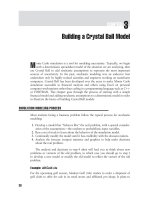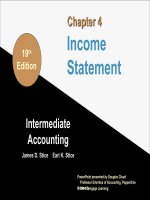Managerial decision modeling with spreadsheets by stair render chapter 04
Bạn đang xem bản rút gọn của tài liệu. Xem và tải ngay bản đầy đủ của tài liệu tại đây (92.95 KB, 37 trang )
Chapter 4:
Linear Programming
Sensitivity Analysis
© 2007 Pearson Education
What if there is uncertainly about one or
more values in the LP model?
Sensitivity analysis allows us to determine
how “sensitive” the optimal solution is to
changes in data values.
This includes analyzing changes in:
1. An Objective Function Coefficient (OFC)
2. A Right Hand Side (RHS) value of a
constraint
Graphical Sensitivity Analysis
We can use the graph of an LP to see what
happens when:
1. An OFC changes, or
2. A RHS changes
Recall the Flair Furniture problem
Flair Furniture Problem
Max 7T + 5C
(profit)
Subject to the constraints:
3T + 4C < 2400
(carpentry hrs)
2T + 1C < 1000
(painting hrs)
T
C < 450
(max # chairs)
> 100
(min # tables)
T, C > 0
(nonnegativity)
Objective Function
Coefficient (OFC) Changes
What if the profit contribution for tables
changed from $7 to $8 per table?
8
Max X7 T + 5 C
(profit)
Clearly profit goes up, but would we want to
make more tables and less chairs?
(i.e. Does the optimal solution change?)
Characteristics of OFC Changes
• There is no effect on the feasible region
• The slope of the level profit line changes
• If the slope changes enough, a different
corner point will become optimal
C
Original
Objective Function
7T + 5 C = $4040
Revised
Objective Function
8T + 5 C = $4360
Optimal Corner
(T=320, C=360)
Still optimal
500
400
300
200
Feasible
Region
100
0
0
100
200
300
400
500 T
What if the OFC
became higher?
Or lower?
11T + 5C = $5500
Optimal Solution
(T=500, C=0)
C
1000
Both have new
optimal corner
points
600
450
3T + 5C = $2850
Optimal Solution
(T=200, C=450)
Feasible
Region
0
0 100
500
800 T
• There is a range for each OFC where the
current optimal corner point remains
optimal.
• If the OFC changes beyond that range a
new corner point becomes optimal.
• Excel’s Solver will calculate the OFC
range.
Right Hand Side (RHS) Changes
What if painting hours available changed
from 1000 to 1300?
X
2T + 1C < 1000
1300
(painting hrs)
This increase in resources could allow us to
increase production and profit.
Characteristics of RHS Changes
• The constraint line shifts, which could
change the feasible region
• Slope of constraint line does not change
• Corner point locations can change
• The optimal solution can change
Old optimal
corner point
(T=320,C=360)
Profit=$4040
C
500
Feasible region
becomes larger
400
New optimal
corner point
(T=560,C=180)
Profit=$4820
300
200
300
400
500
300
100
=1
0
00
Region
0
1C
=1
Feasible
0
+
2T
100
1C
Original
+
2T
200
600 T
Effect on Objective Function Value
New profit
Old profit
Profit increase
= $4,820
= $4,040
= $780 from 300 additional
painting hours
$2.60 in profit per hour of painting
• Each additional hour will increase profit by $2.60
• Each hour lost will decrease profit by $2.60
Shadow Price
The change is the objective function
value per one-unit increase in the
RHS of the constraint.
Will painting hours be worth $2.60 per
hour regardless of many hours are
available ?
Range of Shadow Price Validity
Beyond some RHS range the value of each
painting hour will change.
While the RHS stays within this range, the
shadow price does not change.
Excel will calculate this range as well as the
shadow price.
Solver’s Sensitivity Report
When Excel Solver is used to find an optimal
solution, the option of generating the
“Sensitivity Report” is available.
Go to file 4-1.xls
Constraint RHS Changes
If the change in the RHS value is within the
allowable range, then:
• The shadow price does not change
• The change in objective function value =
(shadow price) x (RHS change)
If the RHS change goes beyond the
allowable range, then the shadow price
will change.
Objective Function
Coefficient (OFC) Changes
If the change in OFC is within the allowable
range, then:
• The optimal solution does not change
• The new objective function value can be
calculated
Anderson Electronics Example
Decision: How many of each of 4 products
to make?
Objective: Maximize profit
Decision Variables:
V = number of VCR’s
S = number of stereos
T = number of TV’s
D = number of DVD players
Max 29V + 32S + 72T + 54D (in $ of profit)
Subject to the constraints:
3V + 4S + 4T + 3D < 4700
2V + 2S + 4T + 3D < 4500
V + S + 3T + 2D < 2500
V, S, T, D > 0
(elec. components)
(nonelec. components)
(assembly hours)
(nonnegativity)
Go to file 4-2.xls
RHS Change Questions
• What if the supply of nonelectrical
components changes?
• What happens if the supply of electrical
components
– increased by 400 (to 5100)?
– increased by 4000 (to 8700)?
• What if we could buy an additional 400
elec. components for $1 more than usual?
Would we want to buy them?
• What if would could get an additional 250
hours of assembly time by paying $5 per
hour more than usual? Would this be
profitable?
Decision Variables That Equal 0
We are not currently making any VCR’s
(V=0) because they are not profitable
enough.
How much would profit need to increase
before we would want to begin making
VCR’s?
Reduced Cost
of a Decision Variable
(marginal contribution to the obj. func. value)
- (marginal value of resources used)
= Reduced Cost
marginal profit of a VCR
= $29
- marginal value of resources = ?
Reduced Cost of a VCR
= - $1.0
Reduced Cost is:
• The minimum amount by which the OFC
of a variable should change to cause that
variable to become non-zero.
• The amount by which the objective
function value would change if the variable
were forced to change from 0 to 1.









